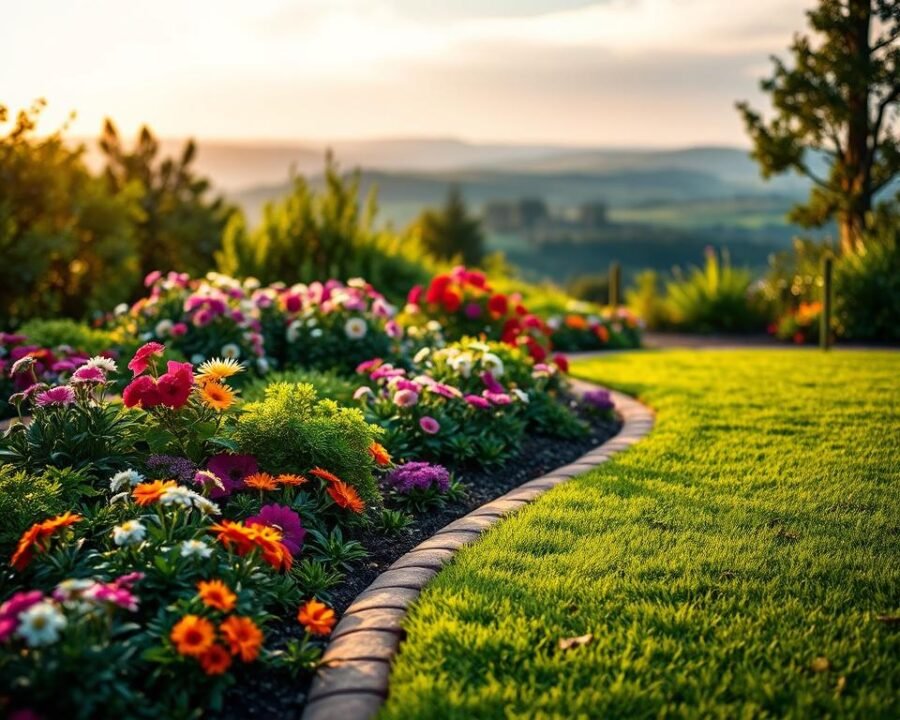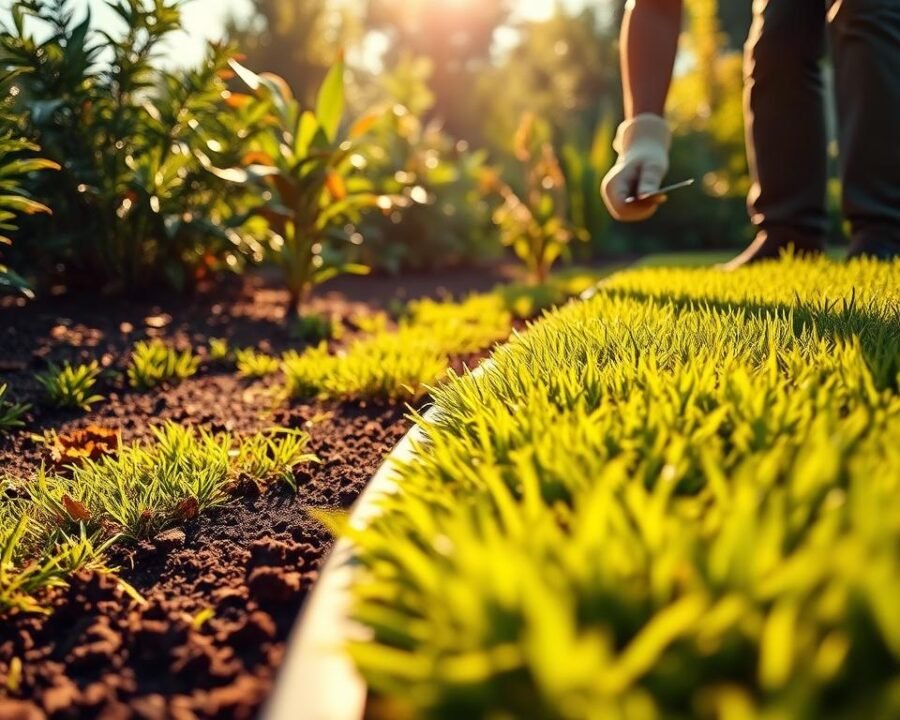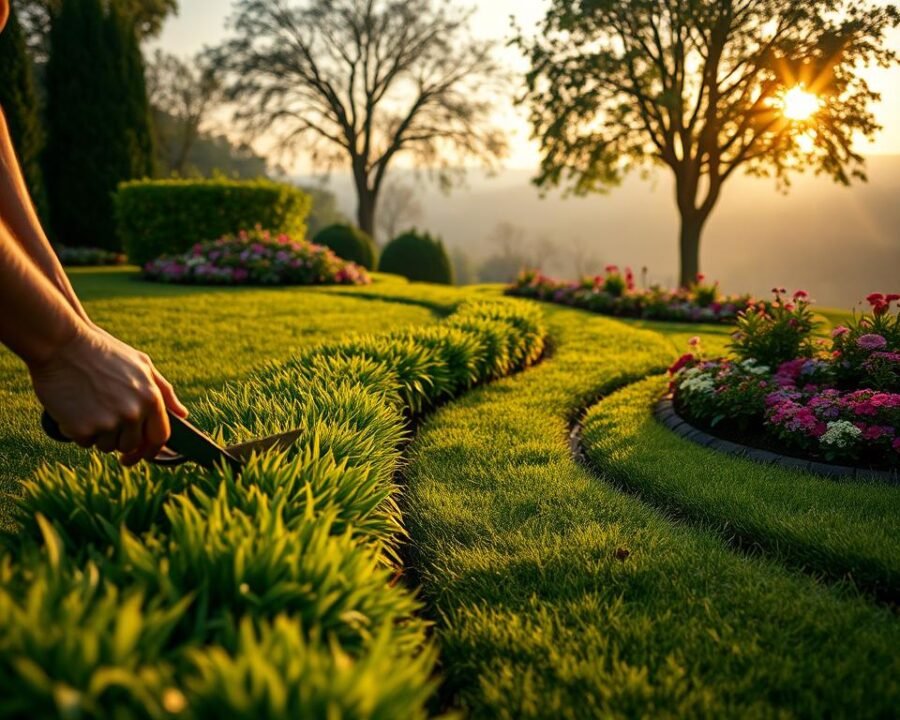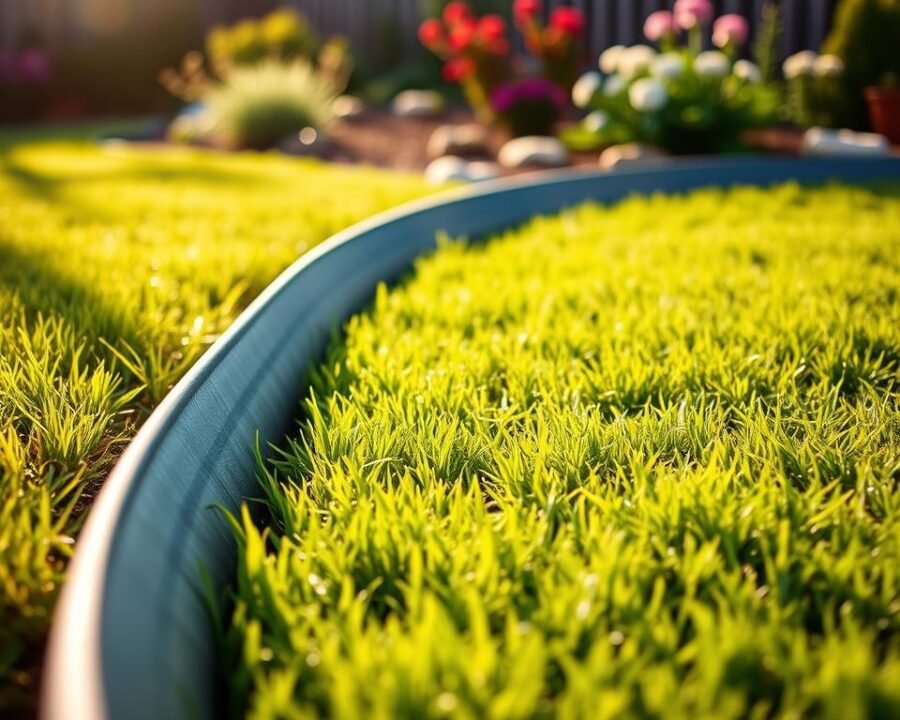We all want our outdoor spaces to show off our personal style. A well-designed garden is a great way to do this. Using 6 inch garden edging is a simple yet effective way to boost your garden’s look.
Adding our Antique Garden Edging to your garden design can make it look beautiful and cohesive. It adds curb appeal to your property. Whether you want to separate areas of your garden or just add a decorative touch, 6 inch edging is perfect.
Key Takeaways
- Add a touch of elegance to your garden with 6 inch edging
- Enhance your outdoor space with a versatile landscaping element
- Create a beautiful and cohesive look with Antique Garden Edging
- Define different areas of your garden with ease
- Add curb appeal to your property with 6 inch garden edging
What is 6 Inch Garden Edging?
6 inch garden edging is key to setting your garden’s borders. It separates garden beds from lawns, driveways, and more. This not only makes your garden look better but also keeps weeds out and soil in.
Definition and Purpose
6 inch garden edging makes your garden look neat by creating clear lines. It stops grass and weeds from getting into flower beds. For something that lasts, try corrugated metal landscape edging, it’s tough and looks good.
Different Types of Edging Materials
There are many materials for durable garden border edging. You can choose from wood, metal, and stone. Wooden edging looks natural and can be shaped easily. Metal edging, like corrugated metal, is strong and modern. Stone edging is elegant and fits many garden styles.
Choosing the right material depends on your garden’s needs and your taste. The right 6 inch garden edging can make your garden look and function better.
Benefits of Using 6 Inch Garden Edging
6-inch garden edging is a versatile and practical solution for garden design and maintenance. It helps create a more defined and visually appealing landscape.
Enhanced Aesthetic Appeal
One of the main benefits of 6-inch garden edging is its ability to enhance your garden’s aesthetic appeal. Its clean lines and defined borders add elegance to your outdoor space. Explore more landscape edging options to find the perfect fit for your garden.
Moreover, the easy installation garden border provided by 6-inch garden edging is attractive for homeowners. It allows them to improve their garden’s appearance without needing extensive landscaping experience.
Practical Landscaping Solutions
6-inch garden edging also offers practical landscaping solutions. It defines different areas within your garden. This edging creates a clear distinction between your garden beds, lawn, and other features, making maintenance easier.
Furthermore, the weather-resistant lawn edging ensures your garden looks great all year. It withstands various weather conditions.
Weed Control and Soil Retention
6-inch garden edging also helps with weed control and soil retention. It creates a barrier between your garden beds and lawn. This prevents weeds from spreading into your garden, reducing the need for herbicides and other weed control methods.

Moreover, the edging retains soil within your garden beds. It prevents erosion and soil loss due to wind or water runoff.
Choosing the Right Material for Your Edging
Choosing the right material for your garden edging can be tough. It depends on your likes, budget, and garden style.
Wood, Metal, or Stone: Which is Best?
Wood, metal, and stone are top picks for garden edging. Each has its own good points and downsides.
- Wooden Edging: Wooden edging fits well with natural or rustic gardens. It’s affordable and easy to set up. But, it needs more care since it can rot or decay.
- Metal Edging: Metal edging is strong and suits modern gardens. It’s pricier and might need a pro to install.
- Stone Edging: Stone edging adds elegance to any garden. It’s durable and low-maintenance. But, it’s heavy and might need extra support.
For more info on the best edging material, check out our article on best material for landscape edging.
Environmental Considerations
Think about the environment when picking your edging material. Some, like certain woods and metals, have a bigger carbon footprint.
| Material | Environmental Impact |
|---|---|
| Wood | Depends on the type of wood and sourcing |
| Metal | High energy consumption during production |
| Stone | Generally considered eco-friendly |
Durability and Maintenance Requirements
How durable and easy to maintain your edging is matters a lot. Stone and metal are more lasting and need less upkeep than wood.
By weighing these points and picking the right material, you can make a beautiful and useful high-quality landscape border. It will make your garden look even better.
Installation Basics for 6 Inch Garden Edging
Our garden edge solution is easy to install, great for DIY fans. With the right tools and some guidance, you can make a stunning garden border. It will make your outdoor space look better.
Tools You’ll Need
Before you start, make sure you have the right tools. You’ll need:
- a measuring tape
- a level
- a shovel or trowel
- a rubber mallet
- the 6-inch garden edging material of your choice

Step-by-Step Installation Guide
Now, let’s get started with the installation steps:
- Measure the area for the edging, including curves and corners.
- Mark the area with a string or hose for a guide.
- Dig a shallow trench, about 2-3 inches deep.
- Put the edging material in the trench, making sure it’s level.
- Use the rubber mallet to tap it into place, securing it in the soil.
- Fill the trench with soil and compact it to prevent settling.
By following these steps, you’ll create a beautiful garden edging. It will enhance your outdoor space’s look.
Creative Design Ideas with Garden Edging
Garden edging is more than just a finishing touch. It’s a creative way to define different areas in your garden. Whether it’s straight, curved, or irregular, an edge can make your garden look better and draw attention to special features.
Our affordable garden edging options let you try out different designs. You can find the perfect one for your garden. Edging can make your garden look modern and sleek or traditional and ornate.
Curved vs. Straight Edging Layouts
Choosing between curved and straight edging depends on your garden’s design. Curved edging adds a soft, flowing touch, making your garden feel natural and relaxed. Straight edging, on the other hand, gives a clean, modern look that’s great for contemporary gardens.
Think about your garden’s landscape and architecture when deciding. For example, curved edges work well with rounded flower beds or winding paths.
Incorporating Edging into Flower Beds
Adding edging to flower beds is a smart way to highlight your plants. It helps separate different plants, making your garden look better.
When picking edging for your flower beds, think about what will look good with your plants. Wooden edging adds a natural, rustic feel. Metal edging gives a sleek, modern look.
| Edging Material | Style | Durability |
|---|---|---|
| Wood | Natural, Rustic | Medium |
| Metal | Modern, Sleek | High |
| Stone | Traditional, Elegant | High |
Maintenance Tips for Garden Edging
Keeping your garden edging in top shape is crucial for a neat outdoor area. A sturdy garden border boosts your garden’s look, fights weeds, and keeps soil in place. Regular upkeep is vital to make your edging last longer.
Seasonal Care and Upkeep
Each season poses unique challenges for garden edging. In spring, check for winter damage. Summer needs regular cleaning to maintain your edging’s appearance. Fall is for preparing your edging for winter by removing leaves and debris. Winter calls for avoiding salt and de-icing chemicals to prevent harm.
Seasonal Tasks:
- Spring: Inspect for damage, repair or replace damaged sections.
- Summer: Regularly clean the edging.
- Fall: Clear leaves and debris.
- Winter: Avoid using de-icing chemicals.
Repairing or Replacing Edging Sections
Edging can wear out over time, needing fixes or new parts. Check your edging often to spot damage early. For small issues, simple repairs can fix them. But big damage might mean you need to replace the whole section.
Repair vs. Replace:
| Condition | Action |
|---|---|
| Minor damage | Repair |
| Extensive damage | Replace |

By sticking to these maintenance tips, your garden edging will stay in great shape all year. Caring for it regularly not only makes your garden look better but also extends your edging’s life.
Popular Brands of 6 Inch Garden Edging
6-inch garden edging is a simple yet effective way to define your garden’s borders. With numerous brands available in the market, choosing the right one can be overwhelming. In this section, we will review some of the leading industry brands that offer high-quality 6-inch garden edging products. We will focus on their features, pricing, and ease of installation.
Overview of Leading Industry Brands
Several brands stand out in the market for their commitment to quality and customer satisfaction. Dakota Tin is known for its corrugated metal landscape edging. It offers a unique blend of durability and aesthetic appeal. Other notable brands include those that specialize in plastic, metal, and stone edging materials, each with its own set of benefits and drawbacks.
When selecting a brand, it’s essential to consider factors such as material, durability, and ease of installation. For instance, Dakota Tin’s corrugated metal edging is not only visually appealing but also provides a sturdy barrier against weeds and soil erosion.
Comparisons of Features and Pricing
To make an informed decision, it’s crucial to compare the features and pricing of different brands. The table below highlights some key differences between popular brands, including Dakota Tin.
| Brand | Material | Ease of Installation | Price Range |
|---|---|---|---|
| Dakota Tin | Corrugated Metal | Easy | $10-$30 |
| Brand X | Plastic | Moderate | $5-$20 |
| Brand Y | Stone | Difficult | $20-$50 |
As shown in the table, Dakota Tin offers a competitive pricing range with easy installation. This makes it an attractive option for those looking for an easy installation garden border. Ultimately, the choice of brand depends on your specific needs and preferences.
DIY Options vs. Ready-Made Edging
Garden edging can be done in two ways: making your own or buying pre-made solutions. Each method has its own pros and cons, which we’ll explore.
Pros and Cons of Each Approach
DIY edging lets you customize your garden’s look. But, it takes time and might need special tools. Ready-made edging is quick and durable, made from materials like weather-resistant lawn edging.
DIY edging can save money by using recycled materials. For example, old bricks or stones can make a beautiful border that matches your garden’s style.
Popular DIY Edging Projects
Popular DIY projects include using wooden planks, metal strips, or stone pavers. These can be arranged in many ways, letting gardeners get creative.
For instance, a simple DIY project is using wooden planks for a rustic border. It’s easy to do with basic tools and skills, making it great for homeowners.
| Material | Durability | Cost |
|---|---|---|
| Wood | Medium | Low |
| Metal | High | Medium |
| Stone | High | High |
Choosing between DIY and ready-made edging depends on durability, upkeep, and looks. By considering these, gardeners can pick what’s best for them.

Edging for Specific Types of Gardens
Gardening fans know that the right edging can make a garden look better. But, the choice of edging depends on the garden type. A good edging can fit many garden styles.
Vegetable Gardens
Edging in vegetable gardens is both useful and pretty. It makes the beds clear, making gardening easier. A good edging for vegetable gardens should be strong and simple to clean.
Using metal or plastic edging is smart. It lasts long and is easy to care for. It also keeps weeds away, helping veggies grow better.
Flower Gardens
Flower gardens need edging that looks good. The edging should make the garden more beautiful. Wood, stone, or metal edging can make a stunning border.
A good edging for flower gardens should look nice and last long. Stone or brick edging adds a classic look. It’s also strong against weather changes.
Rock Gardens and Xeriscapes
Rock gardens and xeriscapes need special edging. They use plants that don’t need much water and decorative rocks. The edging should match the garden’s look and separate areas.
For rock gardens and xeriscapes, using rocks or stones that fit the garden is best. It looks good and saves water, fitting xeriscaping’s goals.
Seasonal Considerations for Garden Edging
To keep our gardens looking great all year, we need to think about the seasons. Each season brings its own challenges for our garden edging. From cold winters to the growth of spring, knowing these changes helps us keep our gardens beautiful.
Edging Before Winter
Before winter, we must prepare our garden edging. We should check for damage and make repairs. For a budget-friendly option, use materials like plastic or metal that can handle frost and moisture.
Here are some steps to get your edging ready for winter:
- Inspect the edging for gaps or loose parts
- Clear debris and leaves from around it
- Apply a protective coating to prevent damage from salt or de-icers
Springtime Edging Practices
When spring arrives, our edging needs some care. We should check for winter damage, clean it, and fix any issues. Spring is the perfect time to make your garden look fresh and new again.
Here are some tasks for spring edging:
| Task | Description |
|---|---|
| Inspect Edging | Check for damage, displacement, or wear |
| Clean Edging | Remove dirt, debris, and winter residue |
| Repair or Replace | Make necessary repairs or replace damaged sections |
Frequently Asked Questions About Garden Edging
Exploring garden edging can raise many questions. It’s a key part of landscaping. Knowing more about it can help you choose the best for your garden.
Common Concerns and Solutions
Homeowners often worry about the durability of garden edging. Will it last, or will it wear out? Our durable garden border is made to last, standing up to weather and heavy use.
Another worry is how easy it is to install. Can you do it yourself, or do you need a pro? Our easy installation garden border is simple to set up. It comes with clear instructions and needs just a few tools.
Other concerns include:
- How do I pick the right material for my garden edging?
- Can garden edging work in different gardens, like vegetable or flower ones?
- How do I keep my garden edging looking good?
Addressing Myths Around Edging
There are myths about garden edging we need to clear up. Some think it’s only for looks, but it also helps with weeds and keeps soil in place.
As a gardening expert,
“Garden edging is not just for looks; it’s essential for a well-kept garden. It marks different areas and stops weeds from spreading.”
This shows garden edging’s many benefits, from looks to practical uses.
By knowing the truth and debunking myths, you can get the most from your garden edging. Enjoy a beautiful, well-kept garden.
Inspiration: Real-Life Garden Edging Projects
We’ve covered a lot about garden edging, from what it is to how to keep it up. Now, let’s see how it changes real gardens. Weather-resistant lawn edging and high-quality landscape borders can truly transform a space.
Transformative Edging Projects
Our customers have seen amazing changes with our edging. A simple garden bed can become a standout feature with the right edging. We’ve seen many before and after photos that show how our edging can change a garden.
Unique Garden Designs
Our landscape borders come in many styles, from curved to straight. They can help you create a garden that’s both unique and beautiful. Whether you’re setting up flower beds, vegetable gardens, or rock gardens, our edging can make it look professional. With a bit of creativity, your garden can become a stunning oasis that shows off your style.
FAQ
What is 6 inch garden edging?
6 inch garden edging is a landscaping tool. It helps separate areas in a garden or yard. It’s a simple way to make outdoor spaces look better.
What materials are used for garden edging?
Garden edging comes in wood, metal, and stone. Each has its own look and needs. The right choice depends on what you like, how long it lasts, and how easy it is to care for.
What are the benefits of using 6 inch garden edging?
6 inch garden edging makes gardens look better. It also helps control weeds and keeps soil in place. Our products are easy to put in and last through weather changes.
How do I choose the right material for my garden edging?
Think about how long it lasts, how easy it is to care for, and the environment. Our landscape borders meet many needs and tastes.
Is 6 inch garden edging easy to install?
Yes, our 6 inch garden edging is simple to install. It’s great for DIY fans. We have a guide on how to install it, including tools and steps.
Can I use garden edging in different types of gardens?
Yes, our garden edging works for many garden types. This includes vegetable, flower, and rock gardens. We offer advice on the best edging for each garden.
How do I maintain my garden edging?
Keep your edging up by following seasonal care tips. Fix or replace damaged parts as needed. Our products are durable, but regular care is key.
Are there different brands of 6 inch garden edging available?
Yes, many brands offer 6 inch garden edging, like Dakota Tin. We compare brands to help you choose.
Can I make my own garden edging?
Yes, you can make your own edging with DIY projects. Think about the pros and cons of DIY versus ready-made products.
How do I prepare my garden edging for winter?
To get your edging ready for winter, follow our seasonal tips. Our affordable options make it easy to keep up with the seasons.
